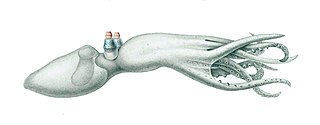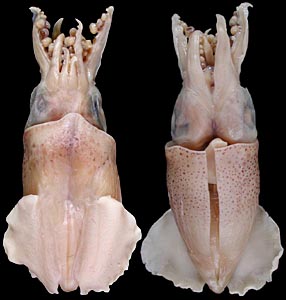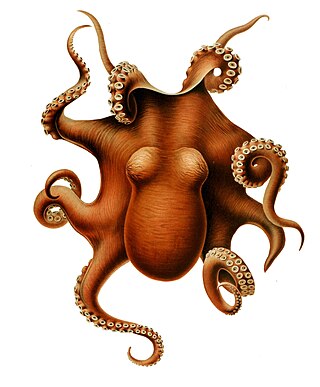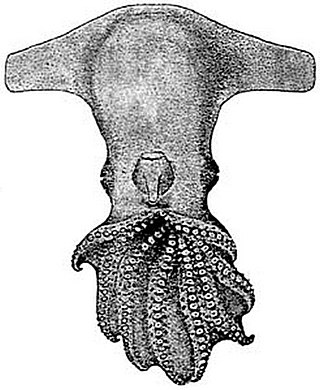
Grimpoteuthis is a genus of pelagic finned or cirrate octopods known as the dumbo octopuses. The name "dumbo" originates from their resemblance to the title character of Disney's 1941 film Dumbo, having a prominent ear-like fin which extends from the mantle above each eye. There are 17 species recognized in the genus. Prey include crustaceans, bivalves, worms and copepods. The average life span of various Grimpoteuthis species is 3 to 5 years.

Opisthoteuthis californiana, also known as the flapjack octopus or adorabilis, is a species of umbrella octopus.

Tremoctopus is a genus of pelagic cephalopods, containing four species that occupy surface to mid-waters in subtropical and tropical oceans. They are commonly known as blanket octopuses, in reference to the long, transparent webs that connect the dorsal and dorsolateral arms of the adult females. The other arms are much shorter and lack webbing.

Cirrina or Cirrata is a suborder and one of the two main divisions of octopuses. Cirrate octopuses have a small, internal shell and two fins on their head, while their sister suborder Incirrina has neither. The fins of cirrate octopods are associated with a unique cartilage-like shell in a shell sac. In cross-section, the fins have distinct proximal and distal regions, both of which are covered by a thin surface sheath of muscle.

The telescope octopus is a species of pelagic octopus found in tropical and subtropical regions of the Indian and Pacific Oceans.

A. aldrichi is a small species of squid found in northern Australian waters. The species was described by Chung Cheng Lu in 2005 based on specimens collected in the inshore waters of Northern Australia. The largest known individual of this species is a mature female measuring 27.6 mm (1.09 in) in mantle length (ML). The holotype is a mature male of 21.3 mm (0.84 in) ML. A live specimen of A. aldrichi has yet to be recorded. A. aldrichi is a member of the class Cephalopoda and part of the subclass Coleodia. Within this class there are two orders, the Myopsida and Oegopsida, which both fall under the superorder Decapodiformes. A. aldrichi falls under the order of Myospida, and is the only member of its genus, Australiteuthis, and family, Australiteuthidae.

Neritidae, common name the nerites, is a taxonomic family of small to medium-sized saltwater and freshwater snails which have a gill and a distinctive operculum.

Neocoleoidea is a large group of marine cephalopods. This cohort contains two extant groups: Decapodiformes and Octopodiformes. Species within this group exist in all major habitats in the ocean, in both the southern and northern polar regions, and from intertidal zones to great depths. Whilst conventionally held to be monophyletic, the only morphological character for the group is the presence of suckers: although the presence of these features in the belemnites suggests that they do not support the Neocoleoidea, and hence that the group may be paraphyletic.
Meruidae is a family of aquatic beetles in the suborder Adephaga, with only one genus and species, Meru phyllisae. The beetle species was first found in the early 1980s. and fully described in 2005. At 0.8 mm (0.031 in), it is one of the smallest adephagan beetles in the world. A survey of aquatic beetles of Venezuela indicated that Meru is most common during the wet season, when larger areas of granitic rock surface are covered with water film, which the adult beetles as well as the larvae inhabit.
The neon flying squid, sometimes called the red flying squid, akaika, and red squid is a species of large flying squid in the family Ommastrephidae. They are found in subtropical and temperate oceanic waters globally.

Cirrate octopuses possess a well-developed internal shell that supports their muscular swimming fins. This is in contrast to the more familiar, finless, incirrate octopuses, in which the shell remnant is either present as a pair of stylets or absent altogether.

Callistoctopus is a genus of nocturnal, orange octopuses in the family Octopodidae. They are readily identifiable by their reddish coloring, the white papillae that line their bodies, and their long arms. Though sympatric with diurnal Octopus species, they avoid competition by hunting at night. In acknowledgement of this preference, many species of Callistoctopus are referred to as night octopuses. Well-known species include C. macropus and the type species C. ornatus, both of which are harvested for human consumption as seafood.

Muusoctopus is a cosmopolitan genus of deep-sea octopus from the family Enteroctopodidae. These are small to medium-sized octopuses which lack an ink sac. Recent work has suggested that these octopuses originated in the North Atlantic and subsequently moved into the North Pacific while the species in the Southern Hemisphere are descended from multiple invasions from northern oceans.

Opisthoteuthis is a genus of cirrate octopuses, sometimes known as flapjack octopuses, which are found in all the world's oceans.
Cirroctopus antartica is a species of deep-sea octopus known from only two specimens, both collected around the Antarctic Peninsula. Its shell is like the letter "U" in shape. It is possible, though not certain, that C. antarctica is a synonym of C. glacialis.
Cirroctopus glacialis is an octopus located in the Palmer Archipelago of Antarctica. Its shell is v-shaped, and it has a distinctive pigmentation pattern on its web's oral face. C. glacialis is thought to be demersal, like other members of the genus Cirroctopus. These octopuses are found between 333 and 914 meters deep. Their population is currently unknown.

Cirroctopus mawsoni is known from only one specimen, which was found in the waters off Adélie Land between 530 and 550 meters deep. It is the type species of genus Cirroctopus. C. mawsoni may be synonymous with Cirroctopus glacialis.
Opisthoteuthis calypso is a species of genus Opisthoteuthis, which are known as the cirrate octopuses. Octopuses in this genus are known as the flapjack octopuses and can be found in a variety of oceans across the world.

Opisthoteuthis agassizii is a lesser-known, deep-sea octopus first described in 1883 by Addison E. Verrill.
Opisthoteuthis bruuni is a species of finned cirrate octopus found along the western coast of South America. Their tissue is almost jelly-like, and they have short, round bodies.













